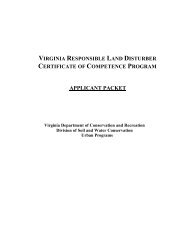Rare Animals - Virginia Department of Conservation and Recreation ...
Rare Animals - Virginia Department of Conservation and Recreation ...
Rare Animals - Virginia Department of Conservation and Recreation ...
You also want an ePaper? Increase the reach of your titles
YUMPU automatically turns print PDFs into web optimized ePapers that Google loves.
Column 5. Federal status:<br />
Federal status is determined by the U.S. Fish <strong>and</strong> Wildlife Service <strong>and</strong> the National Marine Fisheries Service. This status<br />
is used for all animals listed as endangered or threatened by the U.S. government <strong>and</strong> receiving protection under the<br />
federal Endangered Species Act. The list also notes those species that have been formally proposed for listing or are<br />
currently c<strong>and</strong>idates under consideration for listing. The federal status formerly known as “Category 2, c<strong>and</strong>idate<br />
species” was abolished on February 28, 1996; species formerly designated as “Category 1, c<strong>and</strong>idate species” are now<br />
referred to simply as “c<strong>and</strong>idate species.”<br />
LE Listed Endangered. A taxon threatened with extinction throughout all or a significant portion <strong>of</strong> its range.<br />
LT Listed Threatened. A taxon likely to become endangered in the foreseeable future.<br />
LT/SA Listed as Threatened due to Similarity <strong>of</strong> Appearance. The species so closely resembles an endangered or<br />
threatened species or population that enforcement personnel <strong>of</strong> the U.S. Fish <strong>and</strong> Wildlife Service cannot<br />
readily distinguish between the taxa (e.g., the northern population <strong>of</strong> the bog turtle is federally listed as<br />
endangered, but turtles from the southern population, which includes <strong>Virginia</strong>, are not readily distinguishable<br />
from them).<br />
LT/PDL Listed as Threatened but proposed for delisting. The U.S. Fish <strong>and</strong> Wildlife Service has proposed that this<br />
species be removed from the list <strong>of</strong> Endangered <strong>and</strong> Threatened wildlife. However, at the present time, the<br />
species is still listed as Threatened pending further action <strong>and</strong> is thus protected under the Endangered Species<br />
Act.<br />
PE Proposed Endangered. A taxon proposed for listing as endangered.<br />
PT Proposed Threatened. A taxon proposed for listing as threatened.<br />
C C<strong>and</strong>idate. There is enough available information to propose the species for listing, but listing is<br />
“precluded by other pending proposals <strong>of</strong> higher priority”. (Formerly C<strong>and</strong>idate, Category 1)<br />
Column 6. State status:<br />
State status is determined by the <strong>Virginia</strong> <strong>Department</strong> <strong>of</strong> Game <strong>and</strong> Inl<strong>and</strong> Fisheries (all animals except insects) <strong>and</strong> the<br />
<strong>Virginia</strong> <strong>Department</strong> <strong>of</strong> Agriculture <strong>and</strong> Consumer Services (insects only). The informal category <strong>of</strong> “Special Concern”<br />
species that was previously maintained by the <strong>Virginia</strong> <strong>Department</strong> <strong>of</strong> Game <strong>and</strong> Inl<strong>and</strong> Fisheries was abolished by that<br />
agency on January 1, 2011.<br />
LE Listed Endangered; defined as a species that is in danger <strong>of</strong> extinction throughout all or a significant portion<br />
<strong>of</strong> its range.<br />
LT Listed Threatened; defined as a species that is likely to become endangered within the foreseeable future.<br />
4
















